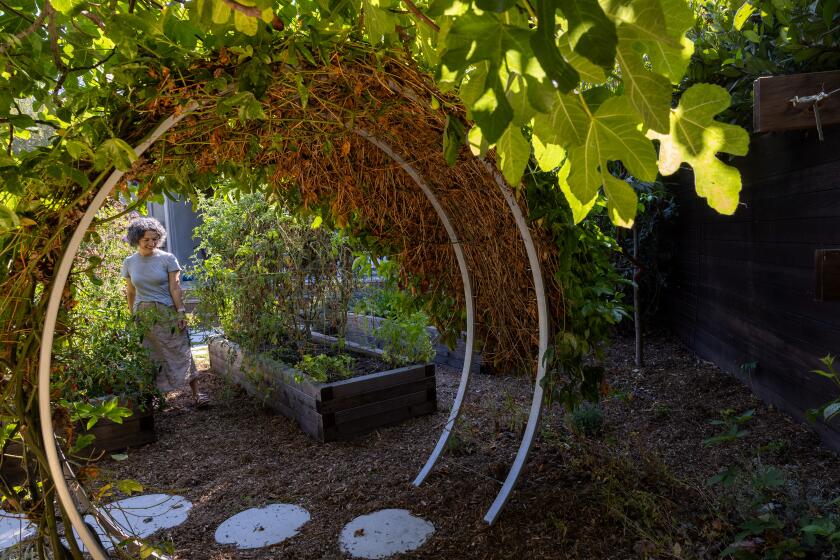GARDENING : ‘Volunteers’ Return to Garden Year After Year : Flowers: California poppies and other self-seeding plants will pop up without work, but not all types may fit the desired color scheme.
Every spring, clusters of California poppies slip into the corners of my garden near the rock walls or between the stepping stones. Their tiny carrot tops quickly grow into clumps of copious blooms that any flower grower would normally prize.
But their powerful orange hue often sabotages my planned color scheme, and their assertive growth obstructs my garden paths. Yet, it’s difficult to refuse these eager volunteers. They’re beautiful, they’re easy to grow and they’re free.
I’ve learned over the years to cope with, and indeed encourage, many self-seeding flowers, particularly those that retain their best characteristics. Some volunteers, through open-garden pollination and lack of selection, become lanky, like coreopsis, or lose their color range, like larkspur. Others, apparently because they are not hybrids, return year after year looking exactly like their parents.
My favorite garden volunteers are gaillardia and rudbeckia. These flowers, with their Indian reds and blazing golds, epitomize California summer gardening. Unlike English gardens bathed in filtered light and washed by almost daily showers, where muted colors and restrained plantings dominate, our gardens are soaked in brilliant sunshine under cloudless blue skies.
California gardens look insipid, even wimpy, without strong color; and these two flowers, both natives of the Americas, are soures of bold and brash hues.
I planted Gaillardia pulchella from seed many years ago, and now it returns every year, even though I dig up the area. This gaillardia produces 2-inch barn-red blooms with petals tipped in gold.
Its sister plant G. grandiflora has somewhat larger blooms. Mine are a wonderful gold with red tips. Gaillardia seedlings are easy to identify in the spring; their hairy leaves are light green and slightly toothed. They thrive in ordinary well-drained soil and get along nicely on sparse water rations.
Complementing the reds and golds of gaillardia flowers is Rudbeckia hirta, commonly called black-eyed Susan or gloriosa daisy. The large cone-centered flowers in the picture are descendants of double gloriosa daisies planted in my garden more than eight years ago. Some are still double, although others have reverted to single status--which is fine with me because the singles tend to stand up better when the wind blows.
Other volunteer rudbeckias in my garden were originally planted as species forms of R. hirta. The 2-inch gold blooms appear on rounded 18-inch plants, and because of their symmetrical shape and their ability to remain upstanding, I’m beginning to like them better than the larger gloriosa daisies.
Poppies are reliable self-seeders, returning year after year to gardens they like. California poppies have to be introduced only once; after that, they produce seeds that are determined to germinate and perpetuate themselves seemingly ever after. By the way, they bear more flowers if they’re not overfed or overwatered.
Shirley poppies are also prodigious seed makers, but the lovely, frilly flowers from seed packets result from careful selection and crossbreeding. In the garden, without that purposeful selection, succeeding year’s crops become less varied and less fancy. Still, Shirley poppies are always pretty, their volunteers always welcome.
Other annuals eager to make repeat performances are alyssum, cosmos, gilia, scabiosa, forget-me-nots, summer chrysanthemums, strawflowers, and linaria.
A few perennials grow easily from their own seeds without a gardener’s attention. In my garden, I continually find baby statice ( Limonium perezii ) plants coming up. When they’re small, it’s easy to transplant them to the right spot or to grow them in a flat for later use.
Rose campion ( Lynchnis coronaria ), its silver foliage contrasting with stunning ruby-colored flowers, delivers babies by the dozen, some so determined to live that they dangle from rock walls, daring me to remove them. Columbine and foxglove volunteers abound, as do dusty miller plantlets. As a bonus, all these plants are fairly drought-tolerant.
To encourage volunteer plants, here are some tips. Let some flowers go to seed; don’t pick them all for bouquets and don’t be too fastidious in cleaning up the garden. To ensure a big return from likely volunteers, shake the dried seed capsules from the plants when you’re pulling them up at this time of the year.
Don’t cultivate too heavily. I must admit, however, that I dig up most of my garden every year, and the volunteers return regardless.
Learn to recognize the seedlings of the good guys. Actually, it may be easier at first to learn to distinguish the bad guys. Normally, a garden has only a few kinds of weeds. If you can identify them when they are small, you can remove them, watching the other seedlings to see what develops. In time, you’ll know all the good plants in their seedling forms.
If I let my Scot’s genes and instincts take over, I could grow an entire garden using just volunteers and perhaps some divisions from overgrown perennials.
Guffey tends a prize-winning flower garden in Malibu.






